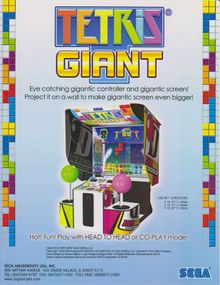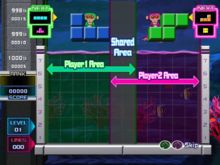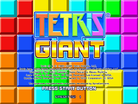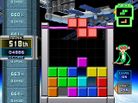Tetris Giant
| Tetris Giant | |
|---|---|
 Promotional flyer | |
| Developer(s) | Sega AM1 |
| Publisher(s) | Sega |
| Platform(s) | Arcade |
| Release |
|
| Gameplay info | |
| Next pieces | 2 |
| Playfield size | 6 × 7 |
| Hold piece | No |
| Hard drop | No |
| Rotation system | SRS |
Tetris Giant (known as テトリス デカリス Tetris Dekaris in Japan) is a Tetris arcade game developed and published by Sega.[1] It was released for arcade on the Sega System SP platform in Japan in December 2009, and in the west in 2010.[2][3]
The word Dekaris comes from the Japanese word Dekai, meaning huge, and -ris from the word Tetris. The game is played using giant versions of ball-top joysticks called Dekacons, on a cabinet with a 70" projector screen. In 2-player mode, players can choose between cooperative or competitive modes.
The game's soundtrack was performed by Team Dekaris (consisting of voice actresses Yui Ogura, Kaori Ishihara, Maho Matsunaga, and Arisa Noto) and produced by Hiroshi Kawaguchi.[4]
Gameplay
As the name implies, everything is giant in Tetris Giant, including the blocks. The playfield is 6 × 7 instead of the normal 10 × 20. The game lacks several Guideline rules, such as hard drop, manual piece locking, and Hold function. Locking a tetromino fully above the 7th row will cause a Lock Out. Pieces appear in the 9th and 10th row, giving extra room to maneuver over the playfield.
Much like Sega Tetris, the pieces have a smooth drop animation instead of the usual step drop. The behavior of tetrominoes does not exactly match Sega Tetris, however; tetrominoes cannot slide under an overhang until they have fully landed. Tetrominoes can slide under an overhang early by rotating, but only if the piece is over half way down a cell in the drop animation. If a tetromino is less than half way down a cell, it can step back up onto the stack by rotating, or moving left or right.
Piece starting positions:
|
|
|
|
|
|
|
|
|
|
|
|
|
|
Arcade operators can also switch the game to Kids mode, which limits the available tetrominoes to JLOIT. In Kids mode single player, only Line Challenge is available.
Score Challenge
The goal of Score Challenge is to score as many points as possible within the 200-line limit, or before topping out. On the left, the Ranking Tower displays the rank in real time, compared to 1000 other scores on the machine.
| Action | Points |
|---|---|
| Single | 10 × level |
| Double | 30 × level |
| Triple | 50 × level |
| Tetris | 500 × level |
| T-Spin | 40 × level |
| T-Spin Single | 90 × level |
| T-Spin Double | 150 × level |
| T-Spin Triple | 210 × level |
| Soft Drop | 2 ÷ cell |
Levels increase every 10 lines, and caps at level 15.
Line Challenge
In this mode, the goal is to clear as many lines as possible before the time runs out or the 200-line limit is reached. By default the time limit is 120 seconds, but the operator can change it to 150 seconds. Bonus time is given when line clears are made. Topping out does not end the game, instead the bottom 7 rows are cleared taking about 3 seconds to resume play. The player receives a grade the more lines they clear. Every 5 lines increases the grade until the Legend grade is reached at 46 lines.
| Action | Time |
|---|---|
| Single | 0 s |
| Double | +2 s |
| Triple | +5 s |
| Tetris | +20 s |
| Grade | Lines |
|---|---|
| D | 0-5 |
| C | 6-10 |
| B | 11-15 |
| A | 16-20 |
| Super | 21-25 |
| Expert | 26-30 |
| Master | 31-35 |
| Wicked | 36-40 |
| Unreal | 41-45 |
| Legend | 46-203 |
Co-op Score Challenge & Co-op Line Challenge

In Co-op mode, two players play cooperatively in a 12 × 7 playfield. The middle two columns are shared, and a player can not move their active piece past that area. You can swap each other's pieces up to three times by pressing the start button.
Versus Mode
In Versus Mode, players share the same piece preview. Clearing multiple lines at once will send an attack to the opponent. A Double sends a Drop Speed Boost attack; the opponent's next piece will drop faster. A Triple sends a 2x Drop Speed Boost. A Tetris sends a 2x Drop Speed Boost and a Line Attack. A Line Attack will add a solid line of garbage that cannot be cleared to the bottom of the recipient's playfield. The first person to win two rounds is the winner.
Development
Tetris Dekaris was announced by Sega on September 11, 2009, and was first playable at the 47th Amusement Machine Show on September 17, 2009.[5] In 2011, A 47” LCD version of the cabinet was also developed, but was only produced in limited quantities.
Release
During the 47th Amusement Machine Show, Amusement Journal asked attendees to fill out a questionnaire of their favorite games. Tetris Dekaris ranked second most popular arcade game on the first two days, and most popular on the last day.[6] As of April 28, 2010, the official website listed 424 locations with a cabinet in operation in Japan.[7]
References
- ↑ "Sega Arcade Game History". Sega Interactive. n.d.. Archived from the original on 2019-09-21. Retrieved 2019-09-21.
- ↑ "SEGA SYSTEM SP HARDWARE". System 16. n.d.. Archived from the original on 2019-09-16. Retrieved 2019-09-21.
- ↑ "Deka i tetorisu, sore ga “dekarisu”!" [Big Tetris, that is "Dekaris"!]. SEGA. n.d.. Archived from the original on 2013-10-16. Retrieved 2019-09-21.
- ↑ "TETRIS DEKARIS Original Soundtrack Koi no DEKARIS". VGMdb. n.d.. Archived from the original on 2019-09-21. Retrieved 2019-09-21.
- ↑ "Deka kute tanoshī tetorisu tōjō" [Tetris Appears Big and Fun]. SEGA. n.d.. Archived from the original on 2013-12-08. Retrieved 2019-09-19.
- ↑ "Ninki kishu rankingu dai 1-nichi-me" [Popular model ranking first day]. Amusement Journal. 2009-09-17. Archived from the original on 2019-09-19. Retrieved 2019-09-19.
- ↑ "Setchi tenpo ichiran" [List of installation stores]. SEGA. 2010-04-28. Archived from the original on 2013-10-18. Retrieved 2019-09-19.
External links
- Official website - Archive
- Tetris Dekaris promo video (『テトリス・デカリス™』プロモーションムービー “Tetorisu dekarisu™” puromōshonmūbī)
| |||||||||||

